The Synergistic Effect in CdS/g-C3N4 Nanoheterojunctions Improves Visible Light Photocatalytic Performance for Hydrogen Evolution Reactions
Abstract
:1. Introduction
2. Results and Discussion
2.1. Crystalline Phases and Texture of Samples
2.2. Morphologies of Photocatalysts
2.3. UV–Vis Diffuse Reflection Spectra
2.4. Photoelectrochemical Properties and Electrochemical Impedance Spectrum Measurements
2.5. Photocatalytic Performance for Hydrogen Evolution Reaction
2.6. Photocatalytic Hydrogen Evolution Reaction Mechanism
3. Experiments
3.1. Photocatalyst Preparation
3.1.1. Preparation of g-C3N4
3.1.2. Preparation of CdS/g-C3N4
3.2. Characterization of Photocatalysts
3.3. Photocatalytic Hydrogen Evolution Reaction Tests
4. Conclusions
Author Contributions
Funding
Institutional Review Board Statement
Informed Consent Statement
Data Availability Statement
Conflicts of Interest
References
- Li, Z.; Sun, Z.; Zhang, G. Combining heterogeneous photocatalysis and enzymatic catalysis via membrane: Conversion of biomass for H2 production from water. Appl. Catal. B Environ. 2023, 338, 123069. [Google Scholar] [CrossRef]
- Huang, M.; Ai, Z.; Xu, L.; Zhang, K.; Kong, Z.; Shao, Y.; Wu, Y.; Hao, X. Band structure-controlled P-C3N4 for photocatalytic water splitting via appropriately decreasing oxidation capacity. J. Alloys Compd. 2022, 895, 162513. [Google Scholar] [CrossRef]
- Fang, F.; Zhang, J.; Su, Z.; Xu, F.; Li, J.; Chang, K. Boost of solar water splitting on SrTiO3 by designing V-ions center for localizing defect charge to suppress deep trap. J. Catal. 2023, 425, 422–431. [Google Scholar] [CrossRef]
- Junaid, M.; Khan, W.Q. Bandgap alignment of solar-driven multilayers metal oxide thin film for water splitting to generate hydrogen energy. Int. J. Hydrogen Energy 2023. [Google Scholar] [CrossRef]
- Hassan, I.U.; Naikoo, G.A.; Salim, H.; Awan, T.; Tabook, M.A.; Pedram, M.Z.; Mustaqeem, M.; Sohani, A.; Hoseinzadeh, S.; Saleh, T.A. Advances in photochemical splitting of seawater over semiconductor nano-catalysts for hydrogen production: A critical review. J. Ind. Eng. Chem. 2023, 121, 1–14. [Google Scholar] [CrossRef]
- Shang, Y.; Fan, H.; Chen, Y.; Dong, W.; Wang, W. Synergism between nitrogen vacancies and a unique electrons transfer pathway of Ag modified S-scheme g-C3N4/CdS heterojunction for efficient H2 evolution. J. Alloys Compd. 2023, 933, 167620. [Google Scholar] [CrossRef]
- Cui, C.; Zhang, G.; Yang, Y.; Wu, T.; Wang, L. Ultra-thin carbon bridged MoC quantum dots/g-C3N4 with charge-transfer-reaction highways for boosting photocatalytic hydrogen production. J. Alloys Compd. 2022, 910, 164864. [Google Scholar] [CrossRef]
- Qin, J.; Jiao, Y.; Liu, M.; Li, Y.; Wang, J. Heat treatment to prepare boron doped g-C3N4 nanodots/carbon-rich g-C3N4 nanosheets heterojunction with enhanced photocatalytic performance for water splitting hydrogen evolution. J. Alloys Compd. 2022, 898, 162846. [Google Scholar] [CrossRef]
- Soltani, H.; Bahiraei, H.; Ghasemi, S. Effect of electrodeposition time on the super-capacitive performance of electrodeposited MnO2 on g-C3N4 nanosheets. J. Alloys Compd. 2022, 904, 163565. [Google Scholar] [CrossRef]
- Geng, L.; Li, W.; Dong, M.; Ma, X.; Li, Y.; Li, M. Synergistic effect of excellent carriers separation and efficient high level energy electron utilization on Bi3+-Ce2Ti2O7/ZnIn2S4 heterostructure for photocatalytic hydrogen production. J. Colloid Interface Sci. 2023, 650, 2035–2048. [Google Scholar] [CrossRef]
- Zhang, Y.; Chen, D.; Li, N.; Xu, Q.; Li, H.; Lu, J. Fabricating 1D/2D Co3O4/ZnIn2S4 core–shell heterostructures with boosted charge transfer for photocatalytic hydrogen production. Appl. Surf. Sci. 2023, 610, 155272. [Google Scholar] [CrossRef]
- Ong, M.; Campbell, Q.; Dabo, I.; Jishi, R.A. First-principles investigation of BiVO3 for thermochemical water splitting. Int. J. Hydrogen Energy 2019, 44, 1425–1430. [Google Scholar] [CrossRef]
- Deng, H.; Wang, J.; Ouyang, Y.; Li, D.; Xiao, Y.; Zhang, Q.; Huang, S. Multiple roles of 2D conductive metal-organic framework enable noble metal-free photocatalytic hydrogen evolution. Appl. Surf. Sci. 2023, 622, 156853. [Google Scholar] [CrossRef]
- Zhang, X.; Ma, X.; Ye, Y.; Guo, C.; Xu, X.; Zhou, J.; Wang, B. Enhanced photocatalytic hydrogen evolution with a Mixed-Valence iron Metal-Organic framework. Chem. Eng. J. 2023, 456, 140939. [Google Scholar] [CrossRef]
- Xie, Z.; Yang, X.; Zhang, P.; Ke, X.; Yuan, X.; Zhai, L.; Wang, W.; Qin, N.; Cui, C.-X.; Qu, L.; et al. Vinylene-linked covalent organic frameworks with manipulated electronic structures for efficient solar-driven photocatalytic hydrogen production. Chin. J. Catal. 2023, 47, 171–180. [Google Scholar] [CrossRef]
- Xu, F.; Liang, B.; Liu, L.; Hu, X.; Weng, B. Pd nanoparticle-decorated covalent organic frameworks for enhanced photocatalytic tetracycline hydrochloride degradation and hydrogen evolution. Chem. Commun. 2023, 59, 6387–6390. [Google Scholar] [CrossRef]
- Ran, Y.; Cui, Y.; Zhang, Y.; Fang, Y.; Zhang, W.; Yu, X.; Lan, H.; An, X. Assembly-synthesis of puff pastry-like g-C3N4/CdS heterostructure as S-junctions for efficient photocatalytic water splitting. Chem. Eng. J. 2022, 431, 133348. [Google Scholar] [CrossRef]
- Zhao, C.; Chen, Z.; Shi, R.; Yang, X.; Zhang, T. Recent Advances in Conjugated Polymers for Visible-Light-Driven Water Splitting. Adv. Mater. 2020, 32, 1907296. [Google Scholar] [CrossRef]
- Yu, W.; Chen, J.; Shang, T.; Chen, L.; Gu, L.; Peng, T. Direct Z-scheme g-C3N4/WO3 photocatalyst with atomically defined junction for H2 production. Appl. Catal. B Environ. 2017, 219, 693–704. [Google Scholar] [CrossRef]
- Hai, G.; Huang, J.; Cao, L.; Kajiyoshi, K.; Wang, L.; Feng, L. Hierarchical W18O49/NiWO4/NF heterojunction with tuned composition and charge transfer for efficient water splitting. Appl. Surf. Sci. 2021, 562, 150145. [Google Scholar] [CrossRef]
- Wang, L.; Wang, Y.; Zhang, A.; Wu, Z. Fabrication of Ag/SnS2/g-C3N4 Z-scheme-type heterojunction photocatalysts with enhanced LED light-driven photoactivity. Inorg. Chem. Commun. 2023, 156, 111144. [Google Scholar] [CrossRef]
- Grushevskaya, S.; Belyanskaya, I.; Kozaderov, O. Approaches for Modifying Oxide-Semiconductor Materials to Increase the Efficiency of Photocatalytic Water Splitting. Materials 2022, 15, 4915. [Google Scholar] [CrossRef] [PubMed]
- Belakehal, R.; Atacan, K.; Güy, N.; Megriche, A.; Özacar, M. Fabrication of heterostructured CdS/g-C3N4/ZnFe2O4 nanocomposite synthesized through ultrasonic-assisted method for efficient photocatalytic hydrogen production. Appl. Surf. Sci. 2022, 602, 154315. [Google Scholar] [CrossRef]
- Ma, X.; Wang, G.; Qin, L.; Liu, J.; Li, B.; Hu, Y.; Cheng, H. Z-scheme g-C3N4-AQ-MoO3 photocatalyst with unique electron transfer channel and large reduction area for enhanced sunlight photocatalytic hydrogen production. Appl. Catal. B Environ. 2021, 288, 120025. [Google Scholar] [CrossRef]
- Wang, X.; Maeda, K.; Thomas, A.; Takanabe, K.; Xin, G.; Carlsson, J.; Domen, K.; Antonietti, M. A metal-free polymeric photocatalyst for hydrogen production from water under visible light. Nature Mater. 2009, 8, 76. [Google Scholar] [CrossRef] [PubMed]
- Liu, X.; Du, Y.; Zhao, Y.; Song, X.; Jing, X.; Yu, L.; Sun, M. 2D Benzodithiophene based conjugated polymer/g-C3N4 heterostructures with enhanced photocatalytic activity: Synergistic effect of antibacterial carbazole side chain and main chain copolymerization. Appl. Catal. B Environ. 2022, 312, 121401. [Google Scholar] [CrossRef]
- Wang, F.; Xu, J.; Wang, Z.; Lou, Y.; Pan, C.; Zhu, Y. Unprecedentedly efficient mineralization performance of photocatalysis-self-Fenton system towards organic pollutants over oxygen-doped porous g-C3N4 nanosheets. Appl. Catal. B Environ. 2022, 312, 121438. [Google Scholar] [CrossRef]
- Xue, X.; Dong, W.; Luan, Q.; Gao, H.; Wang, G. Novel interfacial lateral electron migration pathway formed by constructing metallized CoP2/CdS interface for excellent photocatalytic hydrogen production. Appl. Catal. B Environ. 2023, 334, 122860. [Google Scholar] [CrossRef]
- Wang, Q.; Zhu, S.; Zhao, S.; Li, C.; Wang, R.; Cao, D.; Liu, G. Construction of Bi-assisted modified CdS/TiO2 nanotube arrays with ternary S-scheme heterojunction for photocatalytic wastewater treatment and hydrogen production. Fuel 2022, 322, 124163. [Google Scholar] [CrossRef]
- Zhao, H.; Xing, Z.; Su, S.; Song, S.; Li, Z.; Zhou, W. Gear-shaped mesoporous NH2-MIL-53(Al)/CdS P-N heterojunctions as efficient visible-light-driven photocatalysts. Appl. Catal. B Environ. 2021, 291, 120106. [Google Scholar] [CrossRef]
- Geng, Y.; Chen, D.; Li, N.; Xu, Q.; Li, H.; He, J.; Lu, J. Z-Scheme 2D/2D α-Fe2O3/g-C3N4 heterojunction for photocatalytic oxidation of nitric oxide. Appl. Catal. B Environ. 2021, 280, 119409. [Google Scholar] [CrossRef]
- Ren, Y.; Dong, T.; Ding, S.; Liu, X.; Zheng, H.; Gao, L.; Hu, J. AgBr Nanoparticles Anchored on CdS Nanorods as Photocatalysts for H2 Evolution. ACS Appl. Nano Mater. 2021, 4, 9274–9282. [Google Scholar] [CrossRef]
- Wang, J.-Y.; Hu, Z.-Z.; Sun, X.-T.; Gao, Y.-Q.; Wang, J.-L.; Xu, J.; Jin, G. Highly dispersed CdS on C3N4 for selective cleavage of Cβ-O-4 bonds in lignin model compound under blue light. Surf. Interfaces 2023, 36, 102505. [Google Scholar] [CrossRef]
- Rambabu, P.; Peela, N.R. In-situ CdS nanowires on g-C3N4 nanosheet heterojunction construction in 3D-Optofluidic microreactor for the photocatalytic green hydrogen production. Int. J. Hydrogen Energy 2023, 48, 15406–15420. [Google Scholar] [CrossRef]
- Wang, J.; Pan, R.; Hao, Q.; Gao, Y.; Ye, J.; Wu, Y.; van Ree, T. Constructing Defect-Mediated CdS/g-C3N4 by an In-situ interlocking strategy for cocatalyst-free photocatalytic H2 production. Appl. Surf. Sci. 2022, 599, 153875. [Google Scholar] [CrossRef]
- Wu, C.; Huang, W.; Liu, H.; Lv, K.; Li, Q. Insight into synergistic effect of Ti3C2MXene and MoS2 on anti-photocorrosion and photocatalytic of CdS for hydrogen production. Appl. Catal. B Environ. 2023, 330, 122653. [Google Scholar] [CrossRef]
- Fang, J.; Xie, K.; Kang, Q.; Gou, Y. Facile fabrication of g-C3N4/CdS heterojunctions with enhanced visible-light photocatalytic degradation performances. J. Sci. Adv. Mater. Devices 2022, 7, 100409. [Google Scholar] [CrossRef]
- Tao, J.; Yang, T.; Liu, Q.; Hu, J.; Tang, H. Designing 0D/2D CdS nanoparticles/g-C3N4 nanosheets heterojunction as efficient photocatalyst for improved H2-evolution. Surf. Interfaces 2021, 26, 101312. [Google Scholar]
- Zhang, C.; Liang, Q.; Wang, Y.; Zhou, M.; Li, X.; Xu, S.; Li, Z. Construction of Z-scheme heterojunction CoS/CdS@g-C3N4 hollow sphere with spatical charge separation for enhanced photocatalytic hydrogen production. Appl. Surf. Sci. 2023, 626, 157214. [Google Scholar] [CrossRef]
- Liu, T.; Shen, H.; Wang, M.; Feng, Q.; Chen, L.; Wang, W.; Zhang, J. Fabrication of ZnIn2S4 nanosheets decorated hollow CdS nanostructure for efficient photocatalytic H2-evolution and antibiotic removal performance. Sep. Purif. Technol. 2023, 315, 123698. [Google Scholar] [CrossRef]
- Zhang, Z.; Ji, R.; Sun, Q.; He, J.; Chen, D.; Li, N.; Li, H.; Marcomini, A.; Xu, Q.; Lu, J. Enhanced photocatalytic degradation of 2-chlorophenol over Z-scheme heterojunction of CdS-decorated oxygen-doped g-C3N4 under visible-light. Appl. Catal. B Environ. 2023, 324, 122276. [Google Scholar] [CrossRef]
- Gao, H.; Zhang, S.; Xu, J.; Dou, Y.; Zhou, J.; Zhou, R. Activating and optimizing activity of CdS@g-C3N4 heterojunction for photocatalytic hydrogen evolution through the synergistic effect of phosphorus doping and defects. J. Alloys Compd. 2020, 834, 155201. [Google Scholar] [CrossRef]
- Lu, J.; Shi, Y.; Chen, Z.; Sun, X.; Yuan, H.; Guo, F.; Shi, W. Photothermal effect of carbon dots for boosted photothermal-assisted photocatalytic water/seawater splitting into hydrogen. Chem. Eng. J. 2023, 453, 139834. [Google Scholar] [CrossRef]
- Zhao, W.; Niu, H.; Yang, Y.; Lv, H.; Lv, J.; Cai, Y. One-pot molten salt method for constructing CdS/C3N4 nanojunctions with highly enhanced photocatalytic performance for hydrogen evolution reaction. J. Environ. Sci. 2022, 112, 244–257. [Google Scholar] [CrossRef]
- Niu, Y.; Li, F.; Yang, K.; Wu, Q.; Xu, P.; Wang, R. Highly Efficient Photocatalytic Hydrogen on CoS/TiO2 Photocatalysts from Aqueous Methanol Solution. Int. J. Photoenergy 2018, 2018, 8143940. [Google Scholar] [CrossRef]
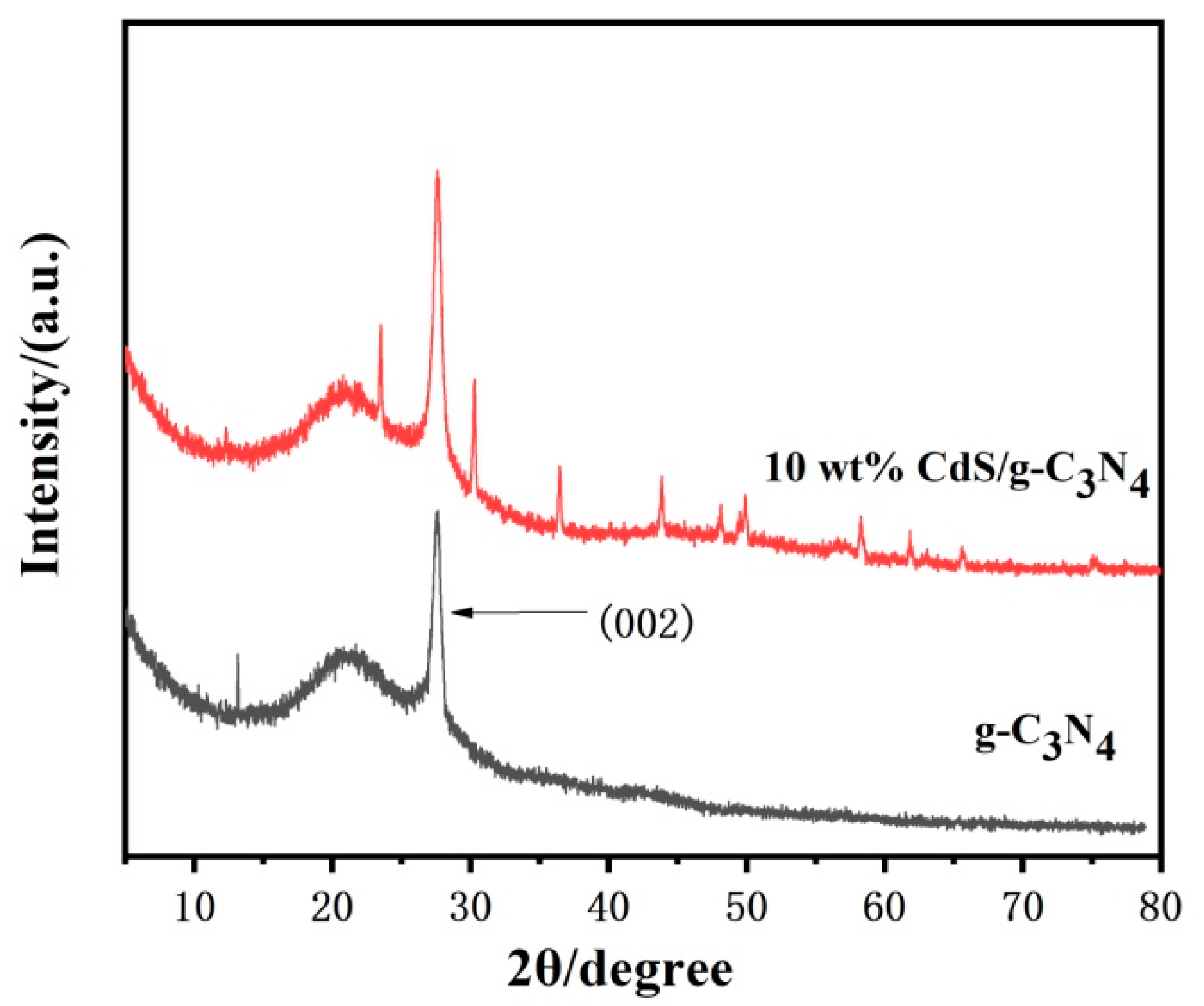


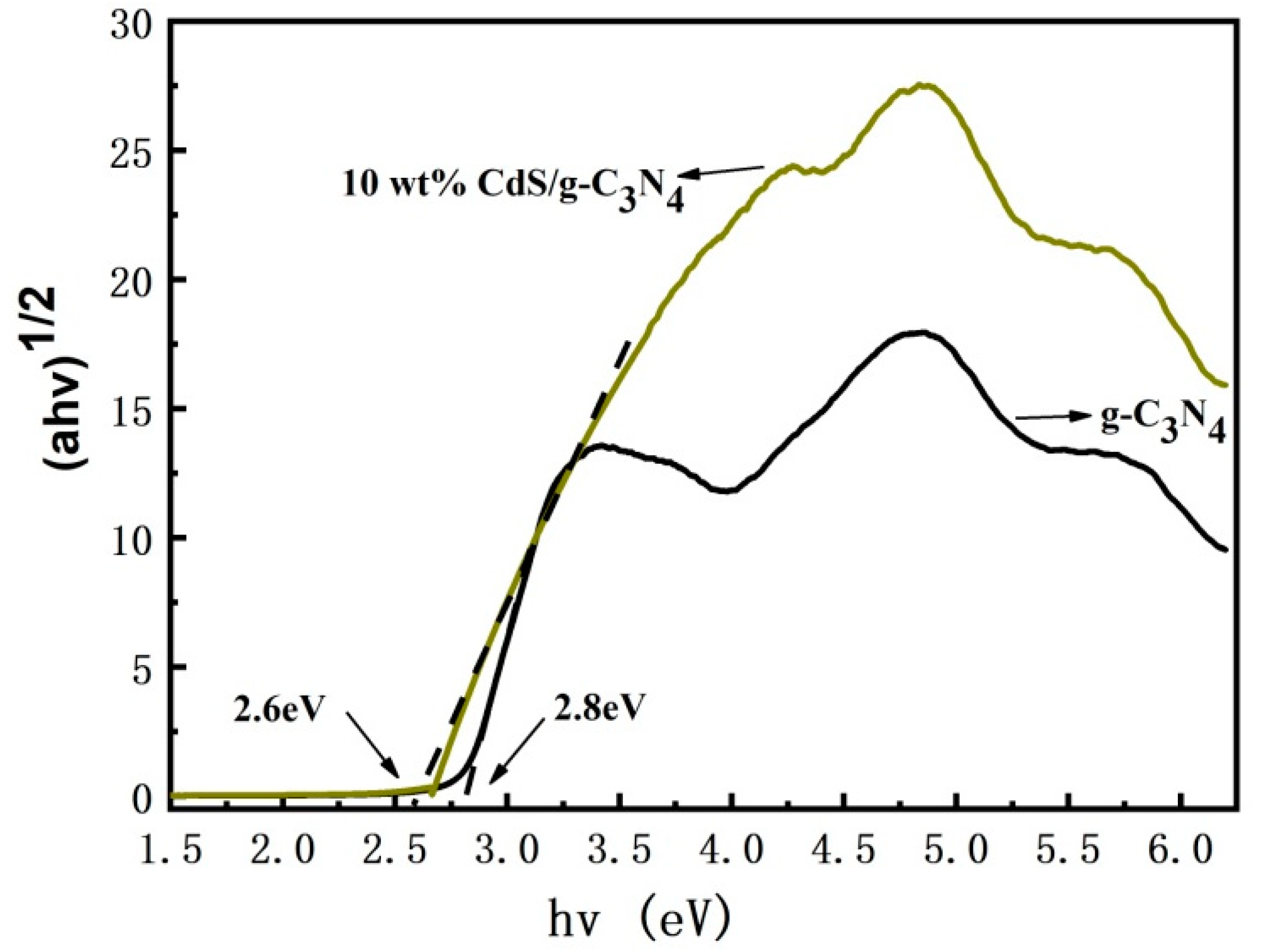

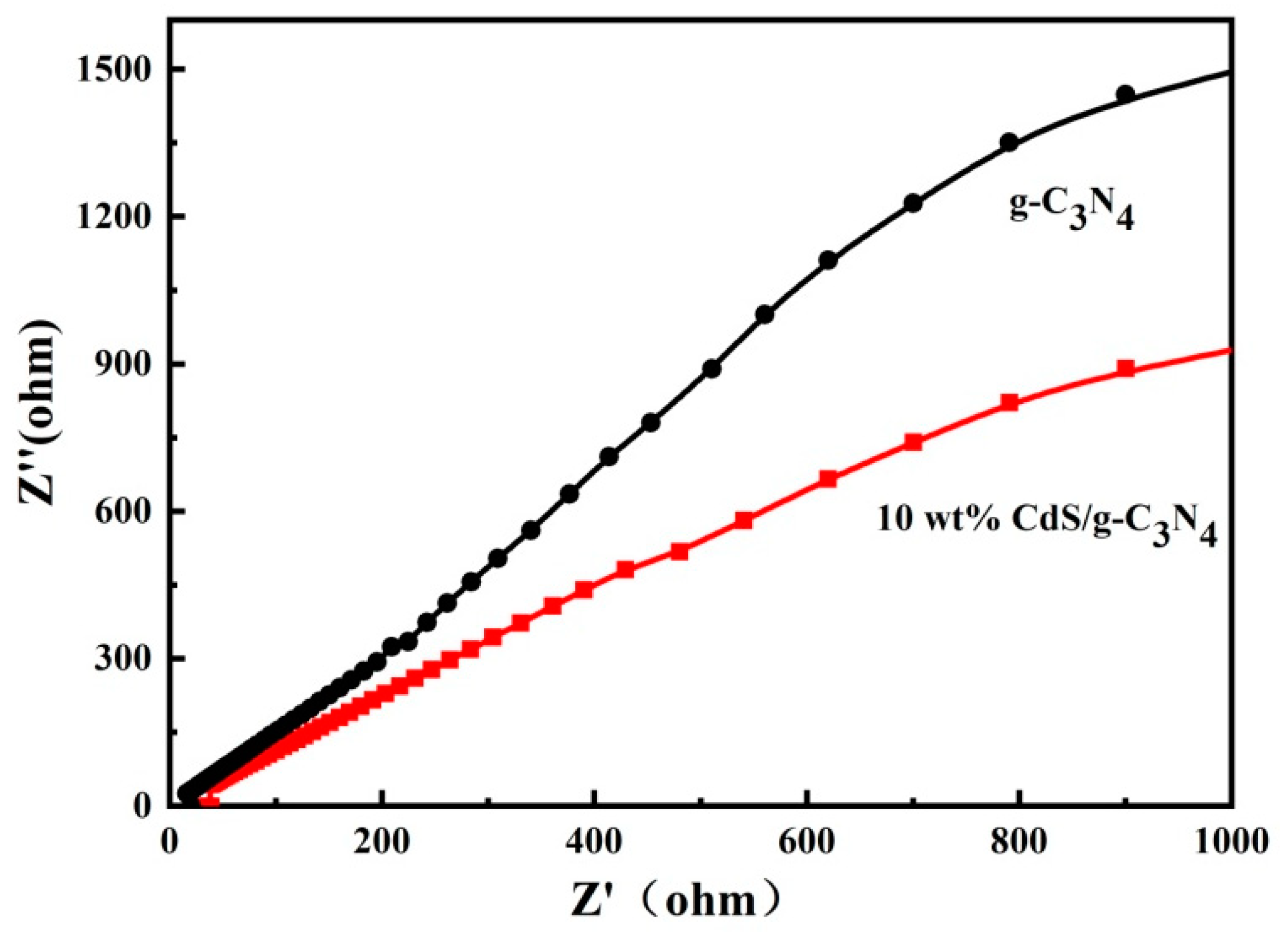
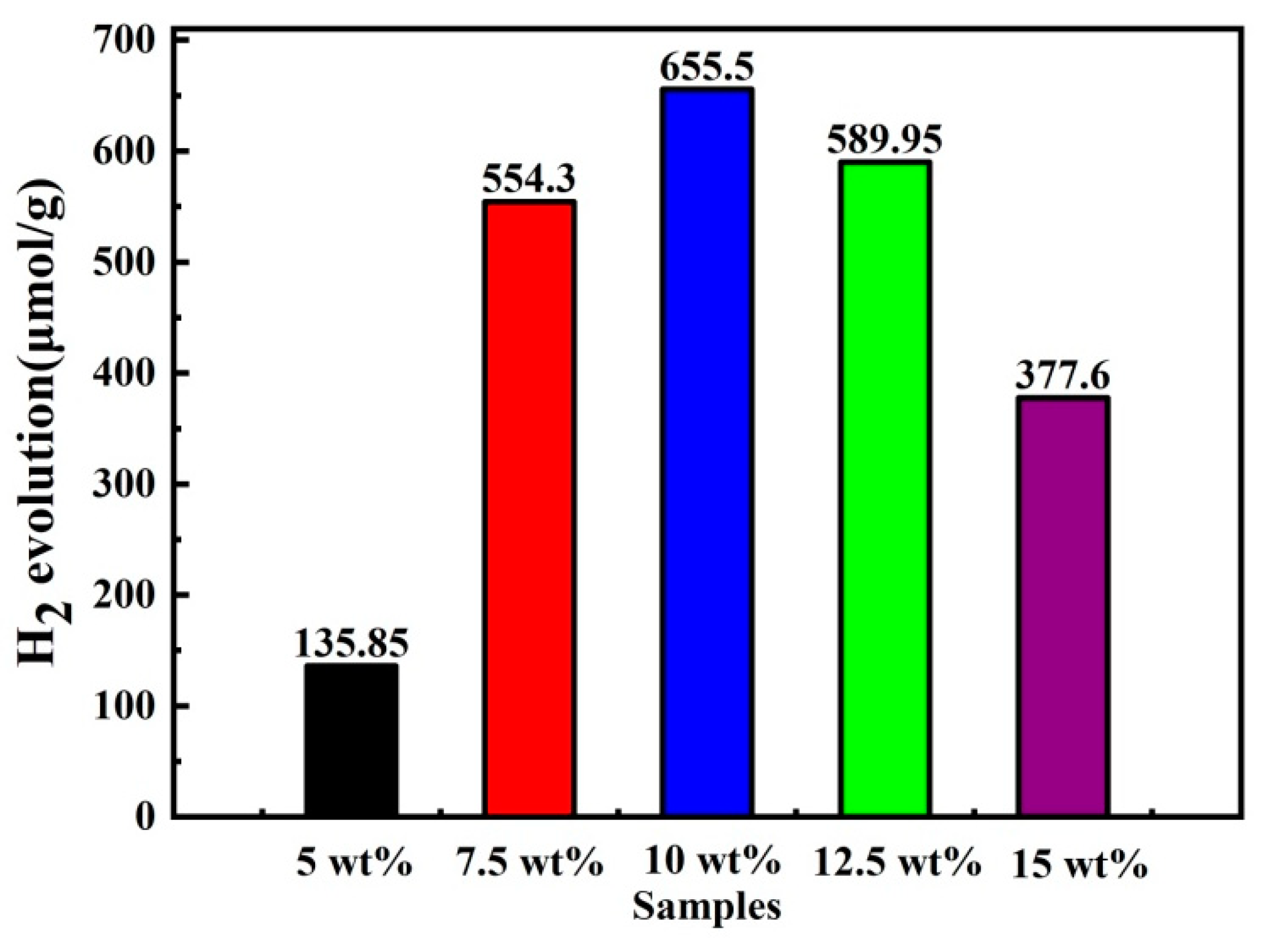
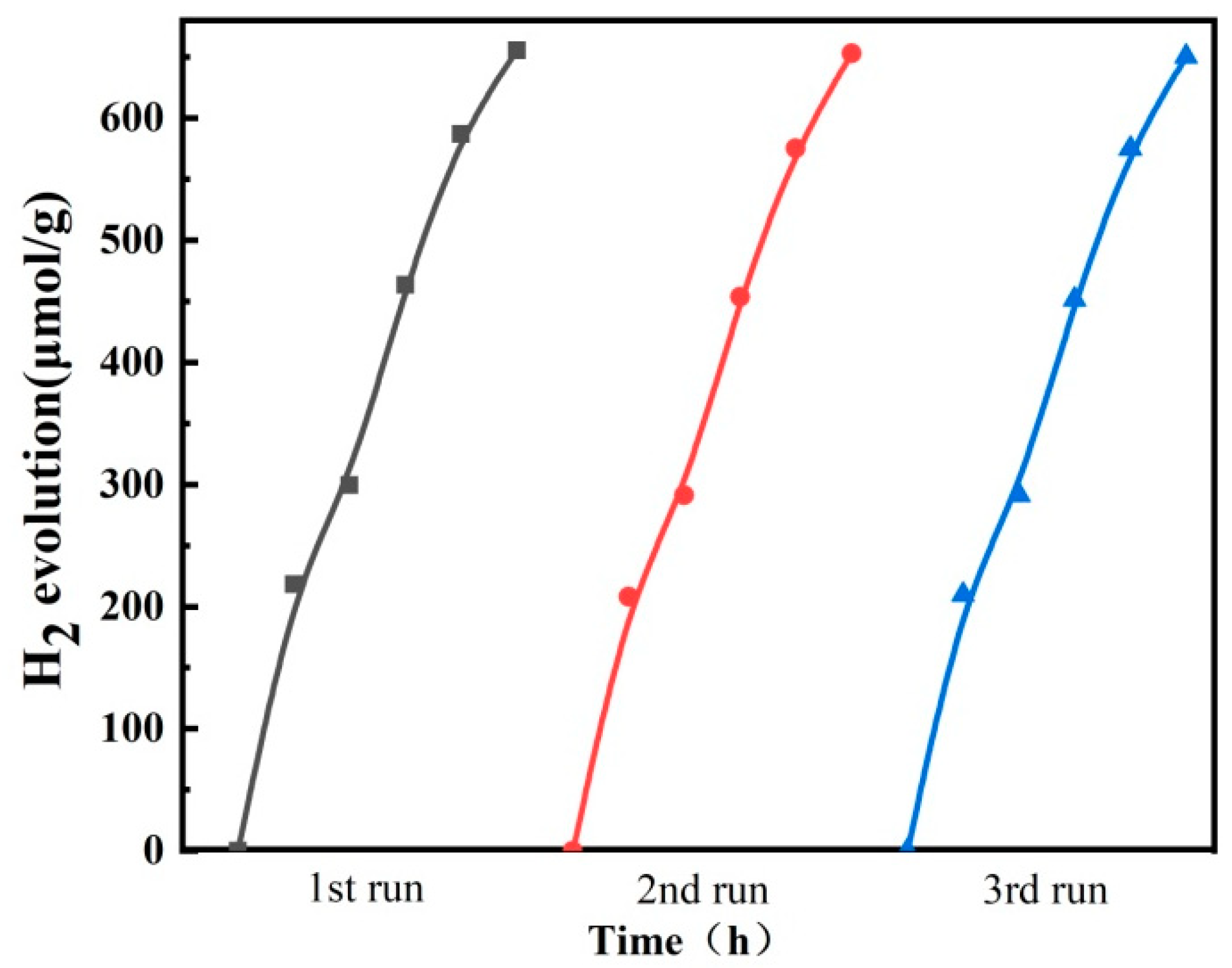
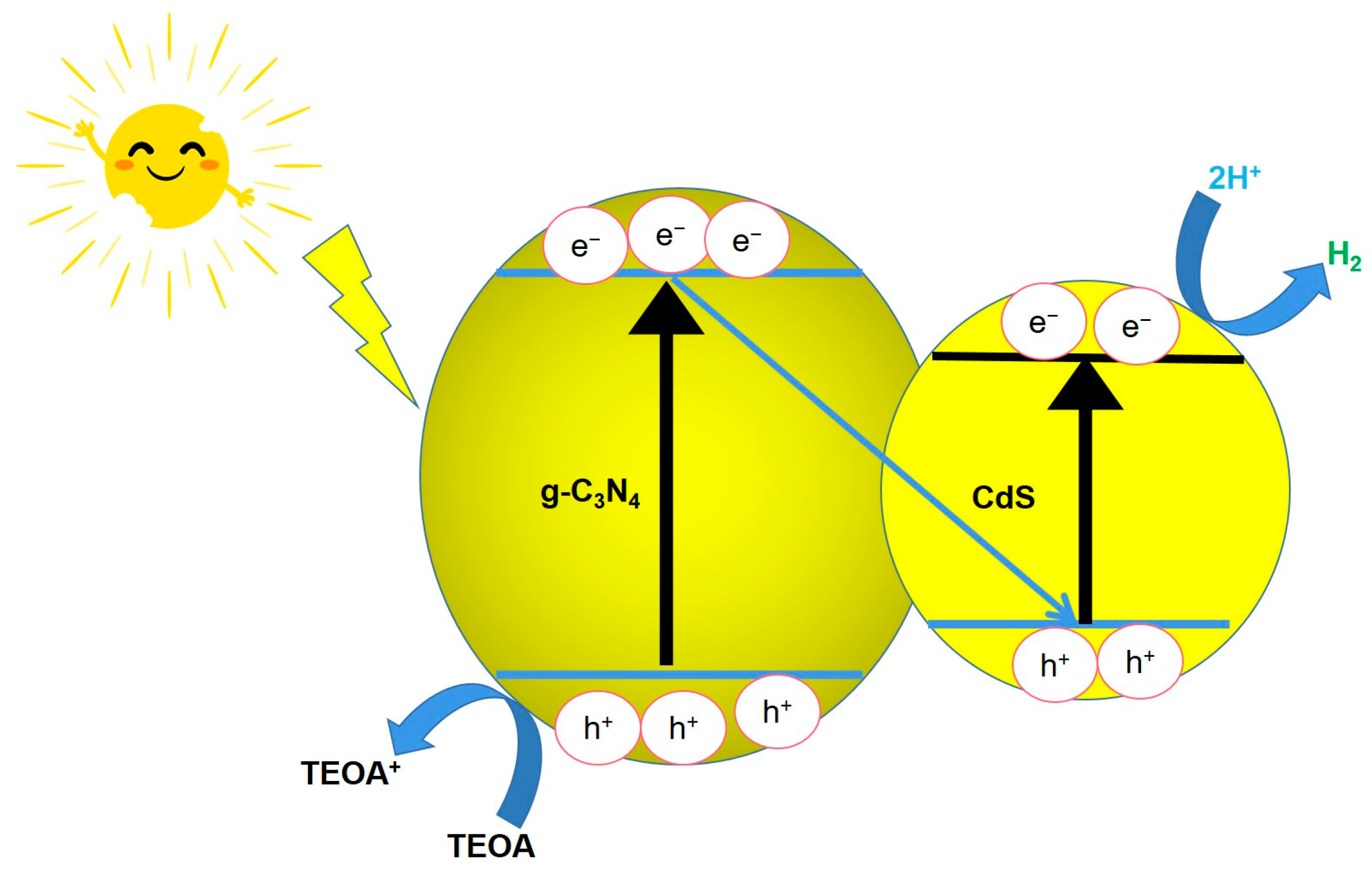
Disclaimer/Publisher’s Note: The statements, opinions and data contained in all publications are solely those of the individual author(s) and contributor(s) and not of MDPI and/or the editor(s). MDPI and/or the editor(s) disclaim responsibility for any injury to people or property resulting from any ideas, methods, instructions or products referred to in the content. |
© 2023 by the authors. Licensee MDPI, Basel, Switzerland. This article is an open access article distributed under the terms and conditions of the Creative Commons Attribution (CC BY) license (https://creativecommons.org/licenses/by/4.0/).
Share and Cite
Niu, Y.; Shen, J.; Guo, W.; Zhu, X.; Guo, L.; Wang, Y.; Li, F. The Synergistic Effect in CdS/g-C3N4 Nanoheterojunctions Improves Visible Light Photocatalytic Performance for Hydrogen Evolution Reactions. Molecules 2023, 28, 6412. https://doi.org/10.3390/molecules28176412
Niu Y, Shen J, Guo W, Zhu X, Guo L, Wang Y, Li F. The Synergistic Effect in CdS/g-C3N4 Nanoheterojunctions Improves Visible Light Photocatalytic Performance for Hydrogen Evolution Reactions. Molecules. 2023; 28(17):6412. https://doi.org/10.3390/molecules28176412
Chicago/Turabian StyleNiu, Yu, Jinni Shen, Wenqin Guo, Xiaoyan Zhu, Lanlan Guo, Yueqi Wang, and Fuying Li. 2023. "The Synergistic Effect in CdS/g-C3N4 Nanoheterojunctions Improves Visible Light Photocatalytic Performance for Hydrogen Evolution Reactions" Molecules 28, no. 17: 6412. https://doi.org/10.3390/molecules28176412
APA StyleNiu, Y., Shen, J., Guo, W., Zhu, X., Guo, L., Wang, Y., & Li, F. (2023). The Synergistic Effect in CdS/g-C3N4 Nanoheterojunctions Improves Visible Light Photocatalytic Performance for Hydrogen Evolution Reactions. Molecules, 28(17), 6412. https://doi.org/10.3390/molecules28176412



